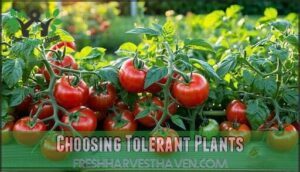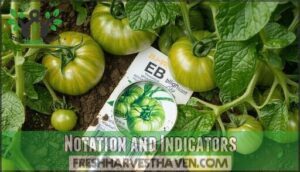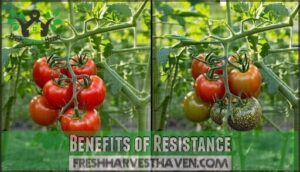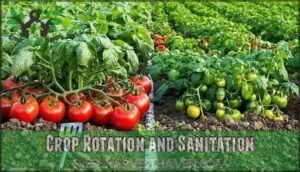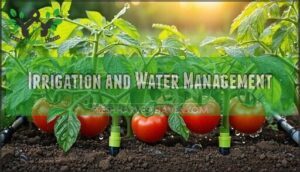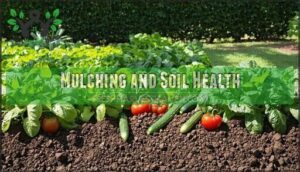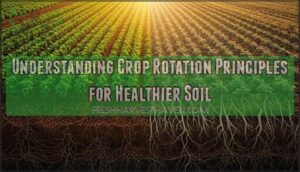This site is supported by our readers. We may earn a commission, at no cost to you, if you purchase through links.
 You can stop early blight on tomatoes with immediate treatment using copper-based fungicides or organic alternatives like baking soda sprays. Remove affected leaves, improve air circulation through pruning, and switch to drip irrigation to reduce leaf wetness. Apply treatments every 7-14 days during active infection. For organic options, try neem oil or compost tea applications.
You can stop early blight on tomatoes with immediate treatment using copper-based fungicides or organic alternatives like baking soda sprays. Remove affected leaves, improve air circulation through pruning, and switch to drip irrigation to reduce leaf wetness. Apply treatments every 7-14 days during active infection. For organic options, try neem oil or compost tea applications.
Prevention involves crop rotation, proper spacing, and selecting resistant varieties like ‘Mountain Magic’ or ‘Defiant PhR’. Clean garden tools between plants to prevent spread.
The key is catching it early—those distinctive bullseye spots mean action time. Success depends on combining multiple strategies that work together.
Table Of Contents
- Key Takeaways
- Early Blight Basics
- Resistant Tomato Varieties
- Cultural Practices Prevention
- Managing Early Blight
- Preventing Future Outbreaks
- Frequently Asked Questions (FAQs)
- How do you treat early blight on tomato plants?
- Can tomato blight be cured?
- What is early blight on tomato plants?
- Does tomato blight kill plants?
- Can fungicides kill tomato blight?
- How do you keep tomato plants blight-free?
- How to get rid of early blight on tomatoes?
- What is the best spray for early tomato blight?
- Which fungicide is best for early blight?
- Which chemical is used to control blight in tomatoes?
- Conclusion
Key Takeaways
- Act immediately when you spot bullseye spots – Remove infected leaves right away and start copper fungicide treatments every 7-14 days to prevent spread throughout your garden.
- Prevent future infections with smart planting – Choose resistant varieties like ‘Mountain Magic’, rotate crops every three years, and space plants properly for better airflow.
- Water at soil level only – Switch to drip irrigation or soaker hoses to keep leaves dry, since wet foliage creates perfect conditions for fungal growth.
- Combine multiple defense strategies – You’ll get best results by mixing resistant varieties, cultural practices, organic treatments, and regular monitoring rather than relying on just one approach.
Early Blight Basics
Early blight strikes when you least expect it, turning healthy tomato plants into spotted, yellowing disasters that can destroy your entire harvest. You’ll recognize this fungal disease by its telltale bullseye-shaped brown spots that start on lower leaves and quickly spread upward through your plants.
Don’t let early blight turn your tomato dreams into a nightmare—these bullseye spots mean business
Definition and Causes
Despite your best gardening efforts, early blight fungal disease can devastate tomato crops. This persistent fungal infection targets the nightshade family through two main culprits: Alternaria solani and Alternaria tomatophila. These early blight pathogens thrive when plant stress weakens your tomatoes’ natural defenses, creating perfect conditions for spore production and disease confusion with other plant ailments.
What makes early blight so devastating:
- Attacks weakened plants when they’re most vulnerable
- Spreads rapidly through contaminated soil and garden tools
- Destroys entire harvests if left untreated
- Returns year after year without proper prevention
Symptoms and Identification
You’ll spot early blight symptoms on your tomato’s lower leaves first—distinctive dark spots with concentric rings that look like tiny bullseyes. These leaf spot patterns start small but expand quickly, surrounded by yellowing tissue that eventually turns brown and drops off.
Stem lesion appearance shows as dark, oval-shaped sunken areas, while seedling blight signs include brown spots just above the soil line. Fruit infection stages create leathery, dark patches that can ruin your harvest.
| Plant Part | Early Symptoms | Advanced Signs |
|---|---|---|
| Leaves | Small dark spots with rings | Yellow halos, leaf drop |
| Stems | Oval sunken lesions | Girdling, plant weakness |
| Fruit | Small dark patches | Large leathery areas |
Distinguishing blights from other diseases is essential—early blight’s signature bullseye pattern sets it apart from late blight’s irregular water-soaked spots.
Disease Cycle and Spread
Understanding the disease cycle helps you fight back effectively. Early blight spores overwinter in soil debris, then activate when humidity reaches 90% and temperatures hit 47-90°F. Here’s how spore dispersal creates problems:
- Rain splash carries fungal spores from infected soil to healthy leaves
- Wind currents transport airborne spores across your garden beds
- Pest transmission occurs when flea beetles carry spores between plants
- Environmental factors like moisture and warmth trigger rapid infection pathways
Resistant Tomato Varieties
Selecting the right tomato varieties can cut your early blight battles in half before you even plant. You’ll want to look for specific resistance markers and understand what tolerance ratings really mean for your garden’s success.
Choosing Tolerant Plants
When early blight strikes, your best defense starts with Hybrid Selection of disease-resistant cultivars. Modern blight resistant tomatoes like ‘Mountain Magic’ and ‘Defiant PhR’ carry Genetic Markers Ph2 and Ph3 that provide up to 60% better tolerance than standard varieties.
| Variety | Resistance Level | Best Growing Region |
|---|---|---|
| Mountain Magic | High (Ph2+Ph3) | All zones |
| Crimson Cherry F1 | Moderate-High | Humid climates |
| Iron Lady | High | Pacific Northwest |
| Plum Regal | Moderate | Southern regions |
Seed Sourcing from reputable suppliers guarantees authentic resistant varieties. Reimer Seeds offers a wide seed variety suitable for diverse gardening needs. Grafting Options onto disease-resistant rootstock boost your plants’ natural defenses even further.
Notation and Indicators
When shopping for tomato seed packets, EB markings signal early blight resistance—your first defense against this destructive disease. These simple codes appear on hybrid varieties that resist blight symptoms naturally.
Look for disease severity ratings that indicate tolerance levels. Understanding these identifying early blight markers helps you select plants with built-in protection, reducing symptom progression before it starts.
Benefits of Resistance
Choosing resistant varieties gives you three powerful advantages that’ll change your tomato game forever. These blight-resistant tomatoes pack genetic markers that boost plant immunity naturally, cutting your workload while maximizing harvests.
- Reduced Fungicides – Slash chemical treatments by 40% with integrated management plans
- Higher Yields – Harvest abundant crops even when disease pressure peaks
- Disease Tolerance – Watch your plants thrive while neighbors’ gardens struggle
- Genetic Markers – Benefit from decades of resistance breeding research
Resistant tomato varieties transform stressful growing seasons into confident success stories through enhanced disease resistance.
Cultural Practices Prevention
You can prevent early blight from taking hold in your tomato garden by focusing on three key cultural practices that create an environment where the fungus struggles to survive.
These proven methods work together to build your plants’ natural defenses while reducing the conditions that allow early blight to spread and establish itself in your garden. These proven methods are essential for maintaining a healthy garden.
Crop Rotation and Sanitation
Smart gardeners know that crop rotation breaks the cycle of soilborne pathogens lurking in your soil. Rotate your crops every three years, moving tomatoes to fresh ground. Practice proper garden sanitation by removing all plant debris—never compost infected materials. Clean tools between plants with rubbing alcohol to prevent spreading spores. Many gardeners find a crop rotation planner helpful for organizing their garden.
| Rotation Benefits | Garden Hygiene | Debris Removal |
|---|---|---|
| Starves pathogens | Tool disinfection | Burn infected plants |
| Improves soil health | Weed control | Remove fallen leaves |
| Reduces disease pressure | Clean containers | Proper disposal methods |
Irrigation and Water Management
Your watering strategy can make or break your battle against early blight. Proper irrigation timing and smart watering techniques create conditions that favor healthy plants over fungal invaders.
Watering Techniques for Disease Prevention:
- Choose drip irrigation over sprinklers – keeps foliage dry while delivering water directly to soil level
- Water early morning only – allows quick evaporation before evening humidity peaks
- Monitor soil moisture consistently – soggy conditions invite trouble while drought stress weakens plant defenses
- Test your water source regularly – contaminated irrigation can introduce pathogens straight to your garden
Deep root watering encourages strong root systems that resist infection. Smart irrigation techniques maintain ideal water soil level without creating humidity havens where Alternaria thrives. Consider drought-resistant plant choices to further reduce watering needs. Focus on drainage solutions if water pools around plants.
Mulching and Soil Health
Mulch Types create barriers against soilborne disease while improving Soil Preparation and Fertility. Strategic mulching with organic materials feeds Soil Microbes that boost Nutrient Availability and Water Retention.
Apply 2-3 inches of straw or shredded leaves around plants, keeping mulch away from stems. Soil Amendments like compost work with mulch to strengthen your tomato’s natural defenses against early blight pathogens lurking in soil.
Managing Early Blight
When early blight strikes your tomato plants, quick action makes the difference between saving your crop and watching it wither away. You’ll need to combine targeted treatments with smart management practices to stop the disease from spreading and protect your remaining harvest.
Organic Treatments and Fungicides
When organic methods aren’t enough, targeted fungicide treatments become essential. Copper-based fungicides provide 50-70% protection when applied weekly during high-risk periods. Potassium bicarbonate offers an eco-friendly alternative that disrupts fungal cell walls. CEASE Biological Fungicide contains Bacillus subtilis bacteria that colonize leaf surfaces, reducing blight severity by 40-60%.
Treatment timing matters most—start applications before symptoms appear for maximum effectiveness. Always follow label instructions carefully, as copper can cause leaf burn if overused. Rotate between different organic fungicides to prevent resistance development. Consider purchasing these products for effective blight control.
Pruning and Airflow Management
Pruning is key to airflow management in your tomato garden. It involves removing lower branches that touch the soil and eliminating suckers that crowd the plant’s center. Adequate airflow, achieved through strategic leaf removal, prevents the humid pockets where early blight thrives.
Proper spacing of plants and the use of vertical support systems further enhance air circulation. These pruning techniques ensure that air reaches all areas of the plant, creating conditions that discourage fungal growth and promote healthier tomatoes.
Tool Sanitation and Handling
Smart sanitation breaks the fungal cycle before it devastates your tomato crop. Here’s your defense strategy:
- Cleaning Solutions: Mix 10% bleach solution for disinfection methods that kill Alternaria spores instantly
- Cross-Contamination Prevention: Clean tools between each plant to prevent fungal infection spread
- Storage Practices: Keep tools dry and separated from infected plant debris
- Sharpening Impact: Sharp, clean tools reduce plant wounds that invite disease
- Handling Practices: Never touch healthy plants after working with infected ones
Smart sanitation breaks the fungal cycle before it devastates your tomato crop. Here’s your defense strategy:
- Cleaning Solutions: Mix 10% bleach solution for disinfection methods that kill Alternaria spores instantly
- Cross-Contamination Prevention: Clean tools between each plant to prevent fungal infection spread
- Storage Practices: Keep tools dry and separated from infected plant debris
- Sharpening Impact: Sharp, clean tools reduce plant wounds that invite disease
- Handling Practices: Never touch healthy plants after working with infected ones
Proper garden maintenance and tool care complement fungicide application perfectly. **Consider crop rotation benefits to further minimize disease.
** Proper garden maintenance and tool care complement fungicide application perfectly.
Preventing Future Outbreaks
Once you’ve treated early blight, you’ll want to create a long-term defense plan to keep your tomatoes healthy in future seasons. Smart soil preparation, strategic companion planting, and consistent monitoring work together to break the disease cycle before it starts.
Soil Preparation and Fertility
Healthy soil forms your strongest defense against early blight before problems start. Begin with soil testing to check soil pH (target 6.0-6.8) and nutrient balance. You can use a reliable testing kit for this purpose.
Work in generous compost additions to build organic matter and improve structure. Consider mycorrhizae inoculation to boost root health and disease resistance.
Remove any plant debris from previous seasons, then apply strategic mulching around plants to prevent soil splashing onto leaves.
Companion Planting and Planning
Strategic companions create powerful pest deterrents around your tomato plants through beneficial herbs and smart space optimization. Plant basil, marigolds, and garlic within thirty centimeters—they release compounds reducing blight by thirty-six percent. These strategic companions support nutrient cycling while forming living barriers. Trap cropping with nasturtiums diverts harmful insects. This companion planting and planning approach protects your nightshade family crops naturally.
Pairing corn and beans, for instance, boosts space efficiency.
Monitoring and Maintenance Strategies
Regular inspection becomes your frontline defense against early blight outbreaks. Check your tomato plants weekly, focusing on lower leaves where symptoms first appear. Timely intervention saves entire crops when you catch problems early.
Monitor these critical indicators for effective plant health management:
- Lower leaf surfaces – Watch for brown spots with concentric rings
- Environmental conditions – Track humidity levels and temperature fluctuations
- Watering patterns – Guarantee proper drainage and avoid overhead irrigation
- Overall plant vigor – Look for yellowing, wilting, or stunted growth
Environmental control through monitoring and maintenance strategies prevents recurring infections. Remove affected leaves immediately and maintain proper fungicide application schedules when necessary for thorough early blight control.
Frequently Asked Questions (FAQs)
How do you treat early blight on tomato plants?
You can’t cure early blight, but copper fungicides and potassium bicarbonate help control it. Start treatment before symptoms appear, spraying every 7-10 days throughout the season for best results.
Can tomato blight be cured?
Unfortunately, tomato blight can’t be cured once it takes hold. You can only manage symptoms and prevent further spread through copper fungicides, cultural practices, and removing infected plant material promptly.
What is early blight on tomato plants?
Early blight is a fungal disease caused by Alternaria solani that creates distinctive brown bullseye spots on tomato leaves, starting from the bottom and moving upward, eventually causing leaf yellowing and drop-off.
Does tomato blight kill plants?
Like a silent predator, early blight weakens tomato plants but doesn’t usually kill them outright. You’ll see leaves yellowing and dropping, reducing fruit production. However, severely stressed plants can eventually die from combined effects.
Can fungicides kill tomato blight?
Yes, fungicides can control tomato blight but won’t cure existing infections. You’ll need copper-based fungicides for organic treatment or synthetic options for conventional growing.
Start applications before symptoms appear and spray every 7-10 days throughout the season.
How do you keep tomato plants blight-free?
You’ll prevent blight by ensuring good airflow through proper plant spacing, watering at soil level, mulching around plants, choosing resistant varieties, and practicing crop rotation annually.
How to get rid of early blight on tomatoes?
You can’t completely cure early blight, but copper fungicides and potassium bicarbonate help control it. Start treatments before symptoms appear and spray every 7-10 days throughout the season.
What is the best spray for early tomato blight?
Copper fungicides show 60% effectiveness against early blight and remain the top choice for organic growers. You’ll want to spray every 7-10 days, starting before symptoms appear for best results.
Which fungicide is best for early blight?
For early blight fungicides, copper-based products work best for organic growers, while potassium bicarbonate offers an eco-friendly alternative.
Start spraying before symptoms appear and continue every 7-10 days throughout the season.
Which chemical is used to control blight in tomatoes?
Studies show copper fungicides reduce early blight severity by up to 75%. You’ll find copper-based fungicides like copper sulfate or copper hydroxide most effective for controlling tomato blight, though potassium bicarbonate offers an eco-friendly alternative option.
Conclusion
Successfully combining absolutely essential early blight treatment for tomatoes requires swift action and consistent follow-through. You’ve learned that copper fungicides, organic alternatives, and cultural practices work best together rather than alone.
Remove infected leaves immediately, improve airflow through strategic pruning, and maintain regular treatment schedules.
Prevention through resistant varieties, proper spacing, and crop rotation creates your strongest defense. Remember, early detection makes the difference between saving your harvest and losing it entirely.

